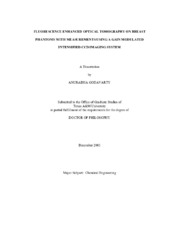| dc.description.abstract | Fluorescence-enhanced optical imaging using near-infrared (NIR) light developed for in-vivo molecular targeting and reporting of cancer provides promising opportunities for diagnostic imaging. However, prior to the administration of unproven contrast agents, the benefits of fluorescence-enhanced optical imaging must be assessed in feasibility phantom studies.
A novel intensified charge-coupled device (ICCD) imaging system has been developed to perform 3-D fluorescence tomographic imaging in the frequency-domain using near-infrared contrast agents. This study is unique since it (i) employs a large tissue-mimicking phantom (~1087 cc), which is shaped and sized to resemble a female breast and part of the extended chest wall region, and (ii) enables rapid data acquisition in the frequency-domain by using a gain-modulated ICCD camera. Diagnostic 3-D fluorescence-enhanced optical tomography is demonstrated using 0.5-1 cc single and multiple targets contrasted from their surrounding by ??M concentrations of Indocyanine green (ICG) in the breast-shaped phantom (10 cm diameter), under varying conditions of target-to-background absorption contrast ratios (1:0 and 100:1) and target depths (up to 3 cm deep). Boundary surface fluorescence measurements of referenced amplitude and phase shift were used along with the coupled diffusion equation of light propagation in order to perform 3-D image reconstructions using the approximate extended Kalman filter (AEKF) algorithm, and hence differentiate the target from the background based on fluorescent optical contrast.
Detection of single and multiple targets is demonstrated under various conditions of target depths (up to 2 cm deep), absorption optical contrast ratio (1:0 and 100:1), target volumes (0.5-1 cc), and multiple targets (up to three 0.5 cc targets). The feasibility of 3-D image reconstructions from simultaneous multiple point excitation sources are presented. Preliminary lifetime imaging studies with 1:2 and 2:1 optical contrast in fluorescence lifetime of the contrast agents is also demonstrated. The specificity of the optical imager is further assessed from homogeneous phantom studies containing no fluorescently contrasted targets.
While nuclear imaging currently provides clinical diagnostic opportunities using radioactive tracers, molecular targeting of tumors using non-ionizing NIR contrast agents tomographically imaged using the frequency-domain ICCD imaging system could possibly become a new method of diagnostic imaging. | en |


